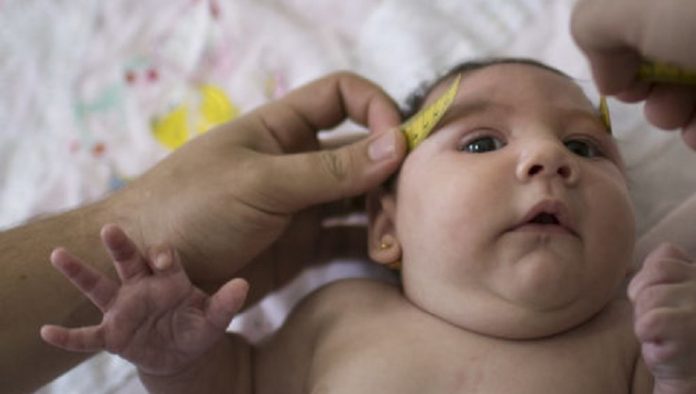
Above, an infant has her head measured by a neurologist to evaluate for signs of microcephaly, a birth defect thought to be associated with Zika infection during pregnancy. Measurements revealed her head to be just 11.4 inches (29 centimeters) in diameter, more than an inch (3 centimeters) below the range defined as healthy by doctors. (Photo Credit: AP)
U.S. health officials on Tuesday issued interim guidelines for health care professionals in the United States caring for infants born to mothers who traveled or lived in an area with Zika virus transmission during pregnancy.
The guidelines from the U.S. Centers for Disease Control and Prevention call for pediatricians to work closely with obstetricians caring for pregnant women exposed to the virus during pregnancy, monitoring fetal ultrasounds and testing infants with signs of a birth defect called microcephaly, which is marked by small head size and often causes lifelong developmental disabilities.
The guidelines come after thousands of infants in Brazil were born with microcephaly, which was believed to be linked to a surge in Zika infections. In studies of the current outbreak in Brazil, genetic material from the Zika virus has been identified in studies of brain tissue, placenta and amniotic fluid from several infants with microcephaly and from miscarried fetuses from women infected with the virus. With huge Zika outbreaks affecting countries across South and Central America, as well as parts of the Caribbean, the CDC has also issued a travel alert urging pregnant women to avoid traveling to those regions.

Above, a child consoles his sibling who was born with microcephaly linked to Zika infection during prenatal development.
Although Zika transmission has not yet been reported in the United States, mosquitoes that carry the infection are endemic to specific regions of the United States, and experts believe transmission is likely in the coming months as the weather heats up. Earlier this month, the U.S. reported its first case of brain damage linked to Zika, in a baby in Hawaii. The mother had been infected with a Zika during a recent trip out of the country.
In the interim guidelines for pediatricians, the CDC recommends that infants with microcephaly born to women exposed to Zika while pregnant should be tested for the virus. For infants without microcephaly but whose mothers received a positive or inconclusive test for the virus, the guidelines call for the child to be tested for possible Zika infection.
The guidance also informs U.S. doctors that Zika is a nationally notifiable condition, meaning that suspected cases must be reported to state and territorial health departments.
No treatments or vaccines are available for Zika virus, but President Obama on Tuesday called for U.S. scientists to accelerate efforts to develop better diagnostic tests, vaccinations, and therapeutics. Since Zika is a close relative of dengue fever, yellow fever, Japanese encephalitis and West Nile, scientists hope to build on their existing knowledge of these diseases to speed up progress towards a Zika vaccine. However, researchers say it will likely take another decade before a vaccine could be made available to the public.
